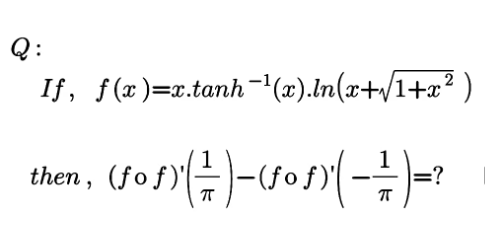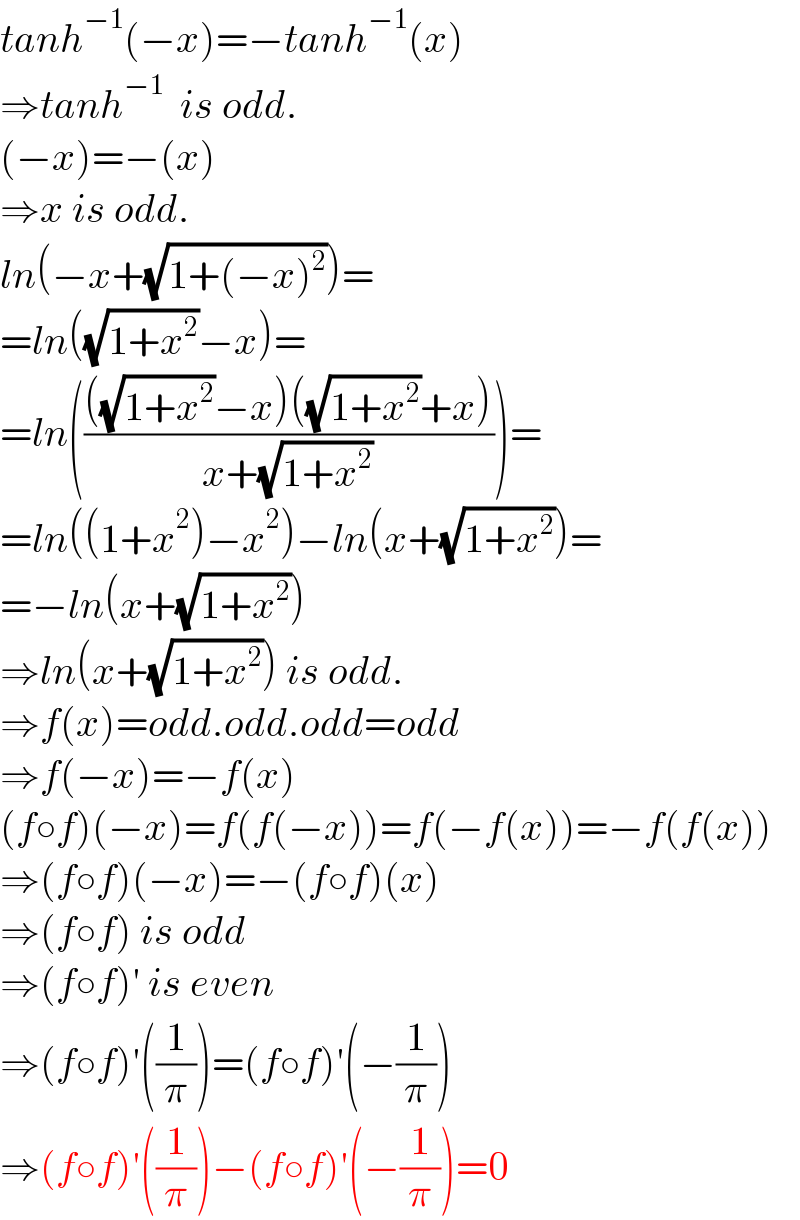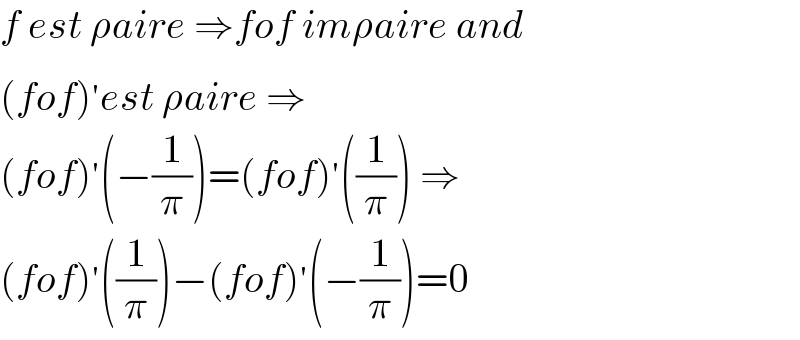Question Number 174635 by mnjuly1970 last updated on 06/Aug/22

Answered by aleks041103 last updated on 06/Aug/22

$${tanh}^{−\mathrm{1}} \left(−{x}\right)=−{tanh}^{−\mathrm{1}} \left({x}\right) \\ $$$$\Rightarrow{tanh}^{−\mathrm{1}} \:\:{is}\:{odd}. \\ $$$$\left(−{x}\right)=−\left({x}\right) \\ $$$$\Rightarrow{x}\:{is}\:{odd}. \\ $$$${ln}\left(−{x}+\sqrt{\mathrm{1}+\left(−{x}\right)^{\mathrm{2}} }\right)= \\ $$$$={ln}\left(\sqrt{\mathrm{1}+{x}^{\mathrm{2}} }−{x}\right)= \\ $$$$={ln}\left(\frac{\left(\sqrt{\mathrm{1}+{x}^{\mathrm{2}} }−{x}\right)\left(\sqrt{\mathrm{1}+{x}^{\mathrm{2}} }+{x}\right)}{{x}+\sqrt{\mathrm{1}+{x}^{\mathrm{2}} }}\right)= \\ $$$$={ln}\left(\left(\mathrm{1}+{x}^{\mathrm{2}} \right)−{x}^{\mathrm{2}} \right)−{ln}\left({x}+\sqrt{\mathrm{1}+{x}^{\mathrm{2}} }\right)= \\ $$$$=−{ln}\left({x}+\sqrt{\mathrm{1}+{x}^{\mathrm{2}} }\right) \\ $$$$\Rightarrow{ln}\left({x}+\sqrt{\mathrm{1}+{x}^{\mathrm{2}} }\right)\:{is}\:{odd}. \\ $$$$\Rightarrow{f}\left({x}\right)={odd}.{odd}.{odd}={odd} \\ $$$$\Rightarrow{f}\left(−{x}\right)=−{f}\left({x}\right) \\ $$$$\left({f}\circ{f}\right)\left(−{x}\right)={f}\left({f}\left(−{x}\right)\right)={f}\left(−{f}\left({x}\right)\right)=−{f}\left({f}\left({x}\right)\right) \\ $$$$\Rightarrow\left({f}\circ{f}\right)\left(−{x}\right)=−\left({f}\circ{f}\right)\left({x}\right) \\ $$$$\Rightarrow\left({f}\circ{f}\right)\:{is}\:{odd} \\ $$$$\Rightarrow\left({f}\circ{f}\right)'\:{is}\:{even} \\ $$$$\Rightarrow\left({f}\circ{f}\right)'\left(\frac{\mathrm{1}}{\pi}\right)=\left({f}\circ{f}\right)'\left(−\frac{\mathrm{1}}{\pi}\right) \\ $$$$\Rightarrow\left({f}\circ{f}\right)'\left(\frac{\mathrm{1}}{\pi}\right)−\left({f}\circ{f}\right)'\left(−\frac{\mathrm{1}}{\pi}\right)=\mathrm{0} \\ $$
Commented by mnjuly1970 last updated on 06/Aug/22

$$\:\:{great}\:…{excellent} \\ $$
Answered by Mathspace last updated on 06/Aug/22

$${f}\:{est}\:\rho{aire}\:\Rightarrow{fof}\:{im}\rho{aire}\:{and} \\ $$$$\left({fof}\right)^{'} {est}\:\rho{aire}\:\Rightarrow \\ $$$$\left({fof}\right)^{'} \left(−\frac{\mathrm{1}}{\pi}\right)=\left({fof}\right)^{'} \left(\frac{\mathrm{1}}{\pi}\right)\:\Rightarrow \\ $$$$\left({fof}\right)^{'} \left(\frac{\mathrm{1}}{\pi}\right)−\left({fof}\right)^{'} \left(−\frac{\mathrm{1}}{\pi}\right)=\mathrm{0} \\ $$
